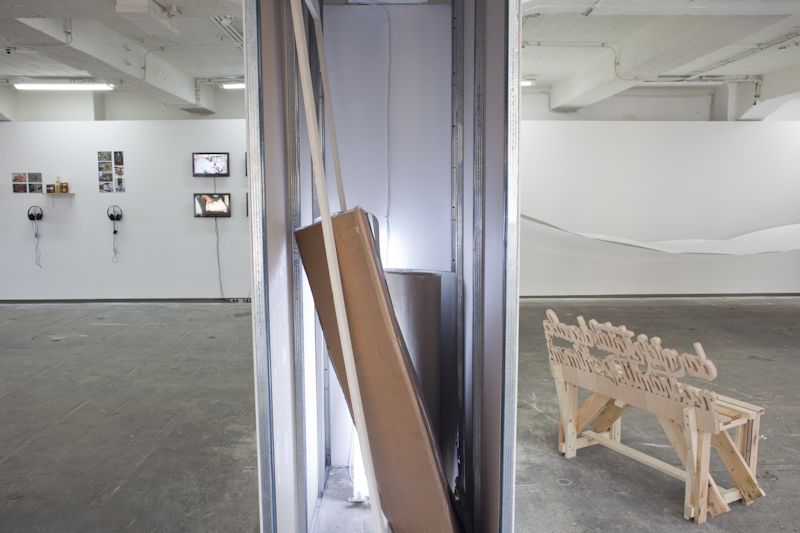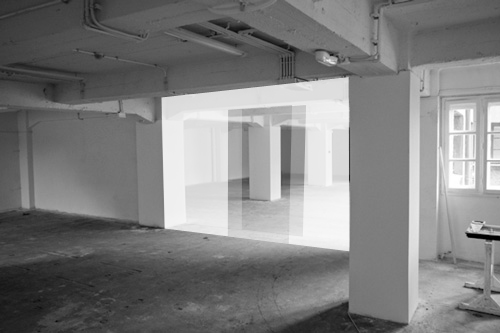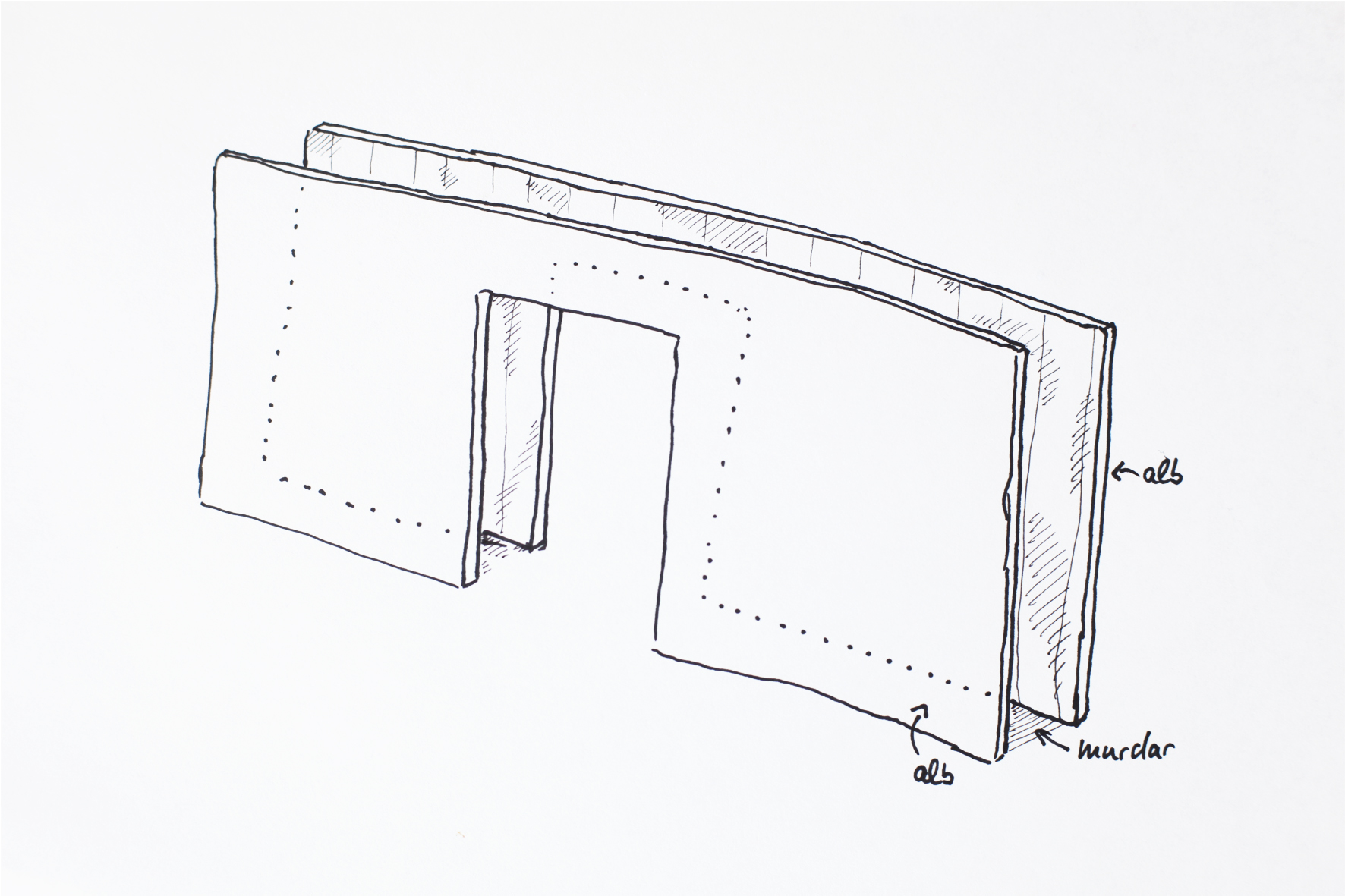
Untitled (Space), 2013
Site-specific installation
Architectural intervention, plaster walls, neon lights, exhibition trash.
2-page text
shown in
It's compulsory that we have a Title →
curated by: Ciprian Mureșan
21. 02. 2013 - 07. 04. 2013
Salonul de Proiecte, Bucharest, Romania
Site-specific installation
Architectural intervention, plaster walls, neon lights, exhibition trash.
2-page text
shown in
It's compulsory that we have a Title →
curated by: Ciprian Mureșan
21. 02. 2013 - 07. 04. 2013
Salonul de Proiecte, Bucharest, Romania
Excerpt from Ciprian Mureșan’s curatorial statement:
Flaviu Rogojan is not sure whether he is an artist or a curator (maybe he’s neither the one nor the other), but I interpreted this ambivalence as a reaction to the wave of painters who throng the streets of Cluj and the Paintbrush Factory. He transforms a space dedicated, i.e. “consecrated”, to exhibitions into one that is ordinary and has no particular function. In other words, he is going against precisely the (praiseworthy) tendency to create as many arts spaces as possible, and I don’t see why he shouldn’t have the right to do so.
Flaviu Rogojan is not sure whether he is an artist or a curator (maybe he’s neither the one nor the other), but I interpreted this ambivalence as a reaction to the wave of painters who throng the streets of Cluj and the Paintbrush Factory. He transforms a space dedicated, i.e. “consecrated”, to exhibitions into one that is ordinary and has no particular function. In other words, he is going against precisely the (praiseworthy) tendency to create as many arts spaces as possible, and I don’t see why he shouldn’t have the right to do so.





Text:
The art space is a rather special kind of place. Whether in the form of a gallery or museum space, the exhibiton site plays by rules which counter the mundane, everyday logic. Due to this conceptual sepparation from all other spaces, the art space earns the power to transmute objects and actions into artworks, as well as temporarily modify the social behaivour of its visitors. In contemporary society, the gallery space has a particular status, similar to other special venues, that encloses a world of its own and, somewhat utopically, creates alternate dimensions. This condition of a staged utopia practically makes the art space a heterotopic* space, a real space of outerworldy otherness.
On a side note, this reminds me of a romanticized story: Once, I was traveling through this far away, small, almost-forgotten village. Someone in the group approached an old woman, and, pointing towards the far end of the road, he asked what lay ahead in that direction; “Nothing, there’s nothing there” she replied. And truly there was nothing, just an empty field that played the part of a sort of void surrounding the village.
Untitled (Space) is an installation that attempts to bring two kinds of heterotopic spaces together by inserting this very kind of romantic “nothing” right through the center of an exhibition space. The fundamental difference of the heterotopia in regards to the commonly familiar space, is its otherness, therefore creating an opposition to all that is seen as ordinary life-frame. But if one were to define both “the gallery”, as well as “the void“ by the same syntagm “opposite of normal”, then the question we come across is: “How do the two relate one to another?” The antagonism between the strip of space which is void (or in-between-content), and the gallery which is a content-filled room, creates a gap, a technical behind-the-scenes space. In order to distinguish between the two, the visitor will eventually end up classifying the small strip as simply not-art space.
The art space is a kind of field that can turn objects, actions, ideas into art, like a magnetic field that can turn iron filings towards one direction or another. Left on their own, the filings can be rotated in any way possible, allowing observation from many different perspectives, but when under the influnce of the magnetic field, this imposes a certain position on them. Art spaces work similarily by activating the potential of objects and actions to turn into art – this being especially visible in the case of ready-mades. They do this by acting on the visitors’ perception. If we were to see this as a mathematical diagram “Untitled(Space)” is the introduction of a gap in the field, one which a travelling visitor can percieve as a drop in field strength, one that makes the artspace temporarily lose its grip on the visitor. To respect a certain kind of mathematical aesthetic the interval divides the gallery space in halves in order to give off construct a certain kind of symmetry.
Two walls contain and delineate the vacuum, but access is still granted; the visitor is free to pass right trough. The room between the two border-walls that shape the void is very narrow, so narrow that it can barely be noticed. The visitor, though, is likely to feel some effect. He may not knowingly recognize the void but clearly senses an interruption. This break is observed as a curatorial effect, that sepparates two chapters in the progression of the exhibition sequence. The main effect of the installation is acting upon the other works in the show. Whether by grouping or by sepparation, the walls add new layers of meaning and understanding.
The resulting confusion is the central subject the work tries to approach. The two walls look exactly like the other gallery walls, so there is no clear visual cue to give away the fact that the installation is not an immediate consequence of exhibition design. It is then easy to misread the intervention as a curatorial intervention in the space. When questioning and contrasting the artistic versus the curatorial, one must take into account the desicion-making hierarchy. What is the territorial reach of the curator’s or artist’s decisions? What is the extent of the artist’s and the curator’s autonomy in the hierarchical decision space of an exhibition? Who is entitled to draw a line? What are the limits of the artwork? Should the resulting spatial organization of the exhibition, or even the exhibition itself, be
considered an artwork as a frame?
Untitled (Space) is about negotiating roles. It is not a project in which negotiations take place, by all means it is a subversive obstacle placed strategically in the curator’s way, that he can only accept and work around. However by questioning the limits of conventional job descriptions, new lines could be drawn and negotiated. The artist becomes the architect, the curator becomes the artist and viceversa, and in the end all that remains is a poorly defined category of creative organizers of ideas and objects in space.
This artwork is merely a tool to initiate debate and trigger thinking. Since contemporary art practices switched from the model of the artist as producer to the artist as selection maker, art objects, especially ready-mades, lose their autonomy. They are no longer sustaining themselves as art objects and are in need of curation. The issues raised by this discussion are relevant even on the local Cluj contemporary art scene, characterized mainly by its underdeveloped institutional and educational backbone. The local situation is unfavourable to conventional curatorial practice and,
due to lack of educational facilities and funding, it has become the norm that the artist must act as a curator himself. It is especially so in the local conservative art school context, which almost exclusively promotes a romanitcized version of the independent genius artist, who is not only selfsufficient but also uncooperative. The same applies when it comes to the visual artist union: curator is not something in itself, but is merely the secondary encumberement someone has to bear when installing an exhibition, being limited mainly to selection and physical spatial organization. The role of the curator is thus undetermined and unclear, lost in a grey area which can sometimes be quite productive, even though not in a conventional sense. Untitled (Space) is both an acceptance and a critique of these modes of practice.
* Michel Foucault, “Des Espace Autres” (“Of Other Spaces”) published in Architecture/Mouvement/Continuité, October 1984
The art space is a rather special kind of place. Whether in the form of a gallery or museum space, the exhibiton site plays by rules which counter the mundane, everyday logic. Due to this conceptual sepparation from all other spaces, the art space earns the power to transmute objects and actions into artworks, as well as temporarily modify the social behaivour of its visitors. In contemporary society, the gallery space has a particular status, similar to other special venues, that encloses a world of its own and, somewhat utopically, creates alternate dimensions. This condition of a staged utopia practically makes the art space a heterotopic* space, a real space of outerworldy otherness.
On a side note, this reminds me of a romanticized story: Once, I was traveling through this far away, small, almost-forgotten village. Someone in the group approached an old woman, and, pointing towards the far end of the road, he asked what lay ahead in that direction; “Nothing, there’s nothing there” she replied. And truly there was nothing, just an empty field that played the part of a sort of void surrounding the village.
Untitled (Space) is an installation that attempts to bring two kinds of heterotopic spaces together by inserting this very kind of romantic “nothing” right through the center of an exhibition space. The fundamental difference of the heterotopia in regards to the commonly familiar space, is its otherness, therefore creating an opposition to all that is seen as ordinary life-frame. But if one were to define both “the gallery”, as well as “the void“ by the same syntagm “opposite of normal”, then the question we come across is: “How do the two relate one to another?” The antagonism between the strip of space which is void (or in-between-content), and the gallery which is a content-filled room, creates a gap, a technical behind-the-scenes space. In order to distinguish between the two, the visitor will eventually end up classifying the small strip as simply not-art space.
The art space is a kind of field that can turn objects, actions, ideas into art, like a magnetic field that can turn iron filings towards one direction or another. Left on their own, the filings can be rotated in any way possible, allowing observation from many different perspectives, but when under the influnce of the magnetic field, this imposes a certain position on them. Art spaces work similarily by activating the potential of objects and actions to turn into art – this being especially visible in the case of ready-mades. They do this by acting on the visitors’ perception. If we were to see this as a mathematical diagram “Untitled(Space)” is the introduction of a gap in the field, one which a travelling visitor can percieve as a drop in field strength, one that makes the artspace temporarily lose its grip on the visitor. To respect a certain kind of mathematical aesthetic the interval divides the gallery space in halves in order to give off construct a certain kind of symmetry.
Two walls contain and delineate the vacuum, but access is still granted; the visitor is free to pass right trough. The room between the two border-walls that shape the void is very narrow, so narrow that it can barely be noticed. The visitor, though, is likely to feel some effect. He may not knowingly recognize the void but clearly senses an interruption. This break is observed as a curatorial effect, that sepparates two chapters in the progression of the exhibition sequence. The main effect of the installation is acting upon the other works in the show. Whether by grouping or by sepparation, the walls add new layers of meaning and understanding.
The resulting confusion is the central subject the work tries to approach. The two walls look exactly like the other gallery walls, so there is no clear visual cue to give away the fact that the installation is not an immediate consequence of exhibition design. It is then easy to misread the intervention as a curatorial intervention in the space. When questioning and contrasting the artistic versus the curatorial, one must take into account the desicion-making hierarchy. What is the territorial reach of the curator’s or artist’s decisions? What is the extent of the artist’s and the curator’s autonomy in the hierarchical decision space of an exhibition? Who is entitled to draw a line? What are the limits of the artwork? Should the resulting spatial organization of the exhibition, or even the exhibition itself, be
considered an artwork as a frame?
Untitled (Space) is about negotiating roles. It is not a project in which negotiations take place, by all means it is a subversive obstacle placed strategically in the curator’s way, that he can only accept and work around. However by questioning the limits of conventional job descriptions, new lines could be drawn and negotiated. The artist becomes the architect, the curator becomes the artist and viceversa, and in the end all that remains is a poorly defined category of creative organizers of ideas and objects in space.
This artwork is merely a tool to initiate debate and trigger thinking. Since contemporary art practices switched from the model of the artist as producer to the artist as selection maker, art objects, especially ready-mades, lose their autonomy. They are no longer sustaining themselves as art objects and are in need of curation. The issues raised by this discussion are relevant even on the local Cluj contemporary art scene, characterized mainly by its underdeveloped institutional and educational backbone. The local situation is unfavourable to conventional curatorial practice and,
due to lack of educational facilities and funding, it has become the norm that the artist must act as a curator himself. It is especially so in the local conservative art school context, which almost exclusively promotes a romanitcized version of the independent genius artist, who is not only selfsufficient but also uncooperative. The same applies when it comes to the visual artist union: curator is not something in itself, but is merely the secondary encumberement someone has to bear when installing an exhibition, being limited mainly to selection and physical spatial organization. The role of the curator is thus undetermined and unclear, lost in a grey area which can sometimes be quite productive, even though not in a conventional sense. Untitled (Space) is both an acceptance and a critique of these modes of practice.
* Michel Foucault, “Des Espace Autres” (“Of Other Spaces”) published in Architecture/Mouvement/Continuité, October 1984